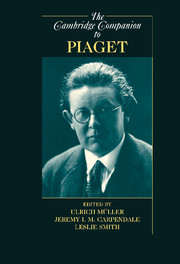Book contents
- Frontmatter
- 1 Introduction: Overview
- 2 The Historical Context Of Piaget’s Ideas
- 3 Piaget’s Developmental Epistemology
- 4 Piaget’s Biology
- 5 On the Concept(s) of the Social in Piaget
- 6 Piaget on Equilibration
- 7 Constructive Processes: Abstraction, Generalization, and Dialectics
- 8 Piaget and Method
- 9 Infancy
- 10 Childhood
- 11 Adolescence
- 12 Piaget’s Theory of Moral Development
- 13 Piaget’s Enduring Contribution to a Science of Consciousness
- 14 Piaget and Affectivity
- 15 Piaget’s Pedagogy
- 16 Piaget in the United States, 1925-1971
- 17 The Mind’s Staircase Revised
- 18 Dynamic Development: A Neo-Piagetian Approach
- Index
1 - Introduction: Overview
Published online by Cambridge University Press: 28 March 2010
- Frontmatter
- 1 Introduction: Overview
- 2 The Historical Context Of Piaget’s Ideas
- 3 Piaget’s Developmental Epistemology
- 4 Piaget’s Biology
- 5 On the Concept(s) of the Social in Piaget
- 6 Piaget on Equilibration
- 7 Constructive Processes: Abstraction, Generalization, and Dialectics
- 8 Piaget and Method
- 9 Infancy
- 10 Childhood
- 11 Adolescence
- 12 Piaget’s Theory of Moral Development
- 13 Piaget’s Enduring Contribution to a Science of Consciousness
- 14 Piaget and Affectivity
- 15 Piaget’s Pedagogy
- 16 Piaget in the United States, 1925-1971
- 17 The Mind’s Staircase Revised
- 18 Dynamic Development: A Neo-Piagetian Approach
- Index
Summary
This introduction is in three parts. In the first part, we comment on the relevance of epistemology for psychology and vice versa. In this context, we briefly elaborate on Piaget's epistemological framework, address some common misconceptions that arise from an overly psychological interpretation of his theory, and introduce the different chapters of this volume. In the second part, Leslie Smith provides a short biography of Piaget. The third part, also by Leslie Smith, points out a number of problems that readers of the English translations of Piaget's work will encounter.
INTRODUCTION I. THE CONTEXT OF PIAGET'S THEORY
Ulrich Müller, Jeremy I. M. Carpendale, and Leslie Smith
The reception of Piaget's work and Piaget's reaction toward this recognition present an interesting puzzle. On the one hand, Piaget is widely recognized for his work on child psychology. For example, in an article on Piaget appearing in a series of papers summarizing the work of eminent developmental psychologists, Harry Beilin (1992, p. 191) wrote the following: “No one affected developmental psychology more than Jean Piaget (1896-1980). From his earliest publication in the 1920s to the time of his death, the inflluence he exercised was extraordinary. His theory . . . has no rival in developmental psychology in scope and depth . . . . The number of experiments conducted by Piaget and his colleagues has never been tabulated, but it is unrivaled in the history of developmental psychology.”
- Type
- Chapter
- Information
- The Cambridge Companion to Piaget , pp. 1 - 44Publisher: Cambridge University PressPrint publication year: 2009
- 4
- Cited by

